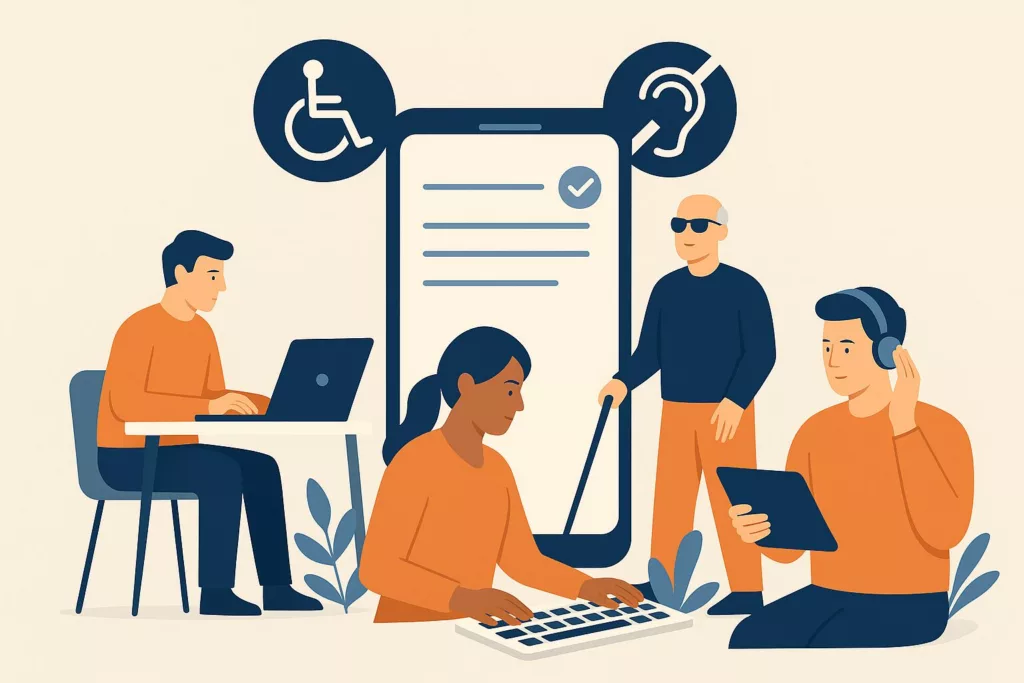Digital accessibility is no longer a niche issue. Starting in June 2025, a new European law will set clear requirements for businesses offering digital services. And no — it’s not just about public institutions or tech giants. SMEs are also affected.
Do you run an e-commerce website, a mobile app, or an online service platform? Then this article is for you.
A New Law Comes Into Effect in June 2025: What It Says
The European Accessibility Act (EAA) is a directive adopted in 2019 that will come into force on June 28, 2025. Its goal? To make digital services and products accessible to everyone, including people with disabilities.
In practice, the law requires a wide range of businesses to:
- make their websites and mobile apps accessible according to specific standards (WCAG),
- ensure accessibility for certain products (such as ATMs, e-readers, etc.),
- clearly communicate the level of accessibility of their services,
- respond to complaints and requests from affected users.
Businesses Affected by the Accessibility Law: Who Needs to Comply?
Contrary to popular belief, this law isn’t just for large corporations or public entities. It has a broad scope. Here are the businesses affected by digital accessibility starting in 2025:
- E-commerce websites, regardless of company size,
- Online banking and insurance services,
- Transportation, ticketing, and booking platforms,
- Mobile apps offering public-facing services,
- E-books and self-service terminals (like interactive kiosks).
In short: if you offer a digital service to EU consumers, you need to prepare.
Accessibility Requirements for SMEs: The End of the Exemption
Until now, many SMEs have been exempt from digital accessibility requirements. But with this new European law, that’s coming to an end. Even small businesses will need to comply if they provide services covered by the directive.
Some Flexibility for Microenterprises
The directive does allow for temporary exemptions for microenterprises (fewer than 10 employees and less than €2 million in turnover), provided they can demonstrate that implementing accessibility would be a disproportionate burden.
However, this exemption is not automatic and does not excuse companies from making basic efforts. And for businesses above this threshold, compliance is mandatory.
Accessibility Thresholds: Where Do You Stand?
This isn’t just about French regulations or the RGAA anymore. In 2025, accessibility thresholds become European. It’s time to ask yourself the right questions:
- Does your company provide a digital service to the public?
- Do you use a website or mobile app to sell, inform, or support users?
- Can you adapt your product or website to meet accessibility standards (keyboard navigation, color contrast, screen reader compatibility, etc.)?
If you answered “yes” to any of these, it’s time to take action
Why Act Now? Don’t Wait Until It’s Too Late
1. Avoid Penalties (and Risky Delays)
EU member states will be able to impose fines — and in some cases, even ban non-compliant products or services from the market.
2. Improve Your Image (and Your SEO)
Accessibility isn’t just a legal checkbox. It’s a performance driver. An accessible website is faster, clearer, easier to use — and better ranked by search engines.
3. Gain Market Share
There are more than 12 million people with disabilities in France alone. Imagine the difference if your website truly welcomed them.
How to Prepare: A Simple, Practical Plan
No need to overhaul everything overnight. Start with this step-by-step plan:
- Accessibility audit: Evaluate your current website or app.
- Technical corrections: Improve keyboard navigation, contrast, HTML structure, etc.
- Accessibility statement: Publish it on your website.
- Continuous improvement plan: Keep optimizing over time.
You can also work with experts to save time and avoid mistakes.
Conclusion: Accessibility in 2025 Starts Now
The European accessibility law is not a threat — it’s an opportunity. An opportunity to make the web fairer, more inclusive, and more efficient.
The businesses affected by accessibility can no longer afford to postpone action. Whether you’re a startup, an SME, or a larger company, now is the time to get started.






